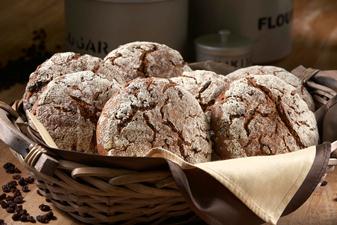 The California Raisin Marketing Board’s (CRMB) fifth-annual America’s Best Raisin Bread Contest is now open, and all industry professionals and student bakers are encouraged to enter their most mouthwatering masterpieces in one or all of the three categories of this competition: Artisan, Commercial and Breakfast. All eligible contestants are:
The California Raisin Marketing Board’s (CRMB) fifth-annual America’s Best Raisin Bread Contest is now open, and all industry professionals and student bakers are encouraged to enter their most mouthwatering masterpieces in one or all of the three categories of this competition: Artisan, Commercial and Breakfast. All eligible contestants are:
-
Bakers and research & development staff of commercial baking companies
-
Craft bakers and retail shop owners/managers
-
Certified baking teachers
-
Students in accredited baking programs
-
Bakery technicians at bakery supply wholesalers, flour milling companies and other allied bakery ingredient suppliers
-
18 years or older
Entries are accepted through July 15, 2012. Contest application, rules and additional details are available at www.loveyourraisins.com. The contest features two divisions, professional and student.
“This competition celebrates the creativity of both seasoned professionals and rising stars in the baking world, while highlighting the versatility of California Raisins as a flavor-packed ingredient,” says Larry Blagg, senior vice president of marketing for the CRMB. “The contest is an ideal way to showcase the endless varieties of delicious bread products that can be made from world-renowned California Raisins.”
Preliminary contest judging will take place in August. A total of 36 finalists will receive a complimentary trip to the American Institute of Baking in Manhattan, Kan., October 11-13, 2012, where they will bake their formulas before a panel of distinguished judges from both the artisan and commercial baking industries. A total of 12 winners—nine in the professional division and three in student division—will be selected.
Winners will be selected based on their formula’s taste, appearance, originality and value. The California Raisin Marketing Board seeks to encourage the use of healthy ingredients. Formulas that feature 100% whole grains and/or gluten-free ingredients will be awarded in each division.
In addition to industry-wide recognition, winning bakers will receive a five-day California educational vacation with visits to The Culinary Institute of America and Yosemite National Park.
Photo: Luminita Cirstea was a recent co-grand-prize winner in “America’s Best Raisin Bread Contest” thanks to her entry, Raisin Rye Bread.
 Thai Fresh Pea Soup is merely one delicious creation that capitalizes on the fresh bounty of the season.
Thai Fresh Pea Soup is merely one delicious creation that capitalizes on the fresh bounty of the season.
 The California Raisin Marketing Board’s (CRMB) fifth-annual America’s Best Raisin Bread Contest is now open, and all industry professionals and student bakers are encouraged to enter their most mouthwatering masterpieces in one or all of the three categories of this competition: Artisan, Commercial and Breakfast. All eligible contestants are:
The California Raisin Marketing Board’s (CRMB) fifth-annual America’s Best Raisin Bread Contest is now open, and all industry professionals and student bakers are encouraged to enter their most mouthwatering masterpieces in one or all of the three categories of this competition: Artisan, Commercial and Breakfast. All eligible contestants are: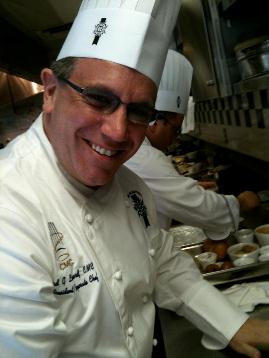 Focused on excellence in culinary education at all levels, Le Cordon Bleu (LCB) College of Culinary Arts is now offering a Certified Master Chef Preparation Program for full-time faculty and academic staff. This new program prepares qualified LCB employees to sit for the Certified Master Chef (CMC) exam—the industry’s highest level of achievement. Not only will the program provide an opportunity for staff to expand their skill set, but those who successfully complete the program will be able to gain recognition for their achievements from the American Culinary Federation.
Focused on excellence in culinary education at all levels, Le Cordon Bleu (LCB) College of Culinary Arts is now offering a Certified Master Chef Preparation Program for full-time faculty and academic staff. This new program prepares qualified LCB employees to sit for the Certified Master Chef (CMC) exam—the industry’s highest level of achievement. Not only will the program provide an opportunity for staff to expand their skill set, but those who successfully complete the program will be able to gain recognition for their achievements from the American Culinary Federation.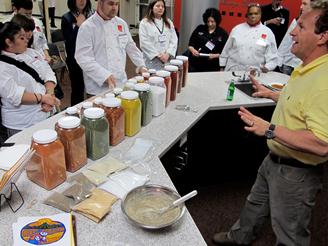 The Institute of Culinary Arts at Robert Morris University held its fifth-annual symposium for culinary students, educators and hospitality professionals on April 13, 2012, at the main RMU campus in downtown Chicago. Titled The Five Taste Senses, the conference focused on the culinary approach to food through the five taste senses of sweet, salty, bitter, sour and umami—a Japanese term meaning “pleasant savory taste.”
The Institute of Culinary Arts at Robert Morris University held its fifth-annual symposium for culinary students, educators and hospitality professionals on April 13, 2012, at the main RMU campus in downtown Chicago. Titled The Five Taste Senses, the conference focused on the culinary approach to food through the five taste senses of sweet, salty, bitter, sour and umami—a Japanese term meaning “pleasant savory taste.” Mary Margaret McCamic, instructor of wine and communication studies at the Morrisville, N.C., campus of The Chef’s Academy (www.thechefsacademy.com), the Culinary Division of Harrison College, recently was awarded the prestigious Wines of Australia Scholarship.
Mary Margaret McCamic, instructor of wine and communication studies at the Morrisville, N.C., campus of The Chef’s Academy (www.thechefsacademy.com), the Culinary Division of Harrison College, recently was awarded the prestigious Wines of Australia Scholarship.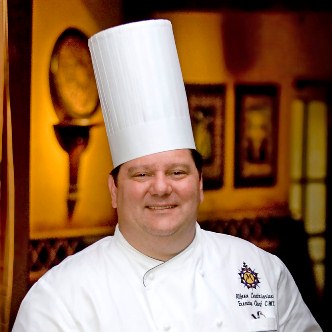 Alfonso Contrisciani, CMC, recently joined the Hocking College McClenaghan Center for Hospitality Training in Nelsonville, Ohio. Contrisciani has 32 years of culinary experience, including orchestrating several presidential dinners in Washington, D.C., as well as President Obama’s Inaugural Balls, and has been featured on Food Network.
Alfonso Contrisciani, CMC, recently joined the Hocking College McClenaghan Center for Hospitality Training in Nelsonville, Ohio. Contrisciani has 32 years of culinary experience, including orchestrating several presidential dinners in Washington, D.C., as well as President Obama’s Inaugural Balls, and has been featured on Food Network.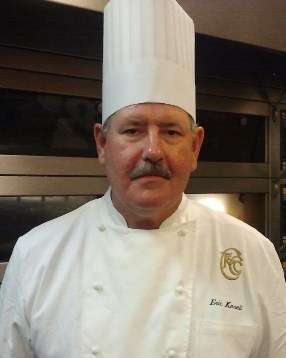 A member of the American Culinary Federation’s chapter in Atlanta lauds the personal and professional value of attending a well-developed and executed monthly meeting.
A member of the American Culinary Federation’s chapter in Atlanta lauds the personal and professional value of attending a well-developed and executed monthly meeting.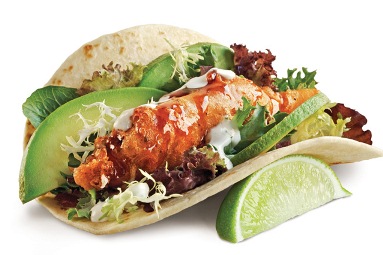 As revealed at this year’s IACP Conference in New York, on the map, but off the beaten path, is where today’s food trends are emerging.
As revealed at this year’s IACP Conference in New York, on the map, but off the beaten path, is where today’s food trends are emerging. National advisory board recommends a more-modern approach to culinary education for the 16 schools in the United States.
National advisory board recommends a more-modern approach to culinary education for the 16 schools in the United States.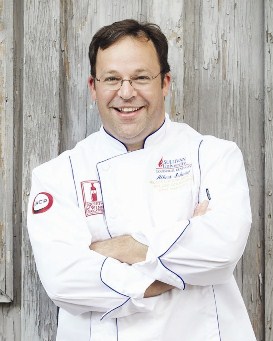 Many students arrive for class thinking they don’t need to know about beverage because they deal with food. Here’s why they’re wrong.
Many students arrive for class thinking they don’t need to know about beverage because they deal with food. Here’s why they’re wrong.